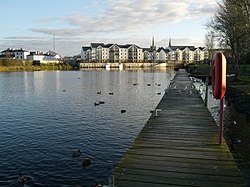Enniskillen: Difference between revisions
Created page with '{{Infobox town | name= Enniskillen | county = Fermanagh | picture= Enniskillen Round O.jpg | picture caption= Enniskillen from the River Erne | latitude= 54.345 | longitude= -…' |
mNo edit summary |
||
| Line 16: | Line 16: | ||
| website= http://www.enniskillen.com/ | | website= http://www.enniskillen.com/ | ||
}} | }} | ||
'''Enniskillen''' is the county town of [[Fermanagh]]. It is almost exactly in the centre of the county between the [[Upper Lough Erne]] and [[Lower Lough Erne]]. The historic centre of the town, | '''Enniskillen''' is the county town of [[Fermanagh]]. It is almost exactly in the centre of the county between the [[Upper Lough Erne]] and [[Lower Lough Erne]]. The historic centre of the town, the location of Enniskillen Castle, is on an island between two streams of the [[River Erne]]. | ||
The town is a centre for boating and watersports, due to its place by Lough Erne. It had a population of 13,599 in the 2001 Census. | The town is a centre for boating and watersports, due to its place by Lough Erne. It had a population of 13,599 in the 2001 Census. | ||
Revision as of 13:05, 24 September 2010
| Enniskillen | |
| Fermanagh | |
|---|---|
 Enniskillen from the River Erne | |
| Location | |
| Grid reference: | H240440 |
| Location: | 54°20’42"N, 7°38’24"W |
| Data | |
| Population: | 13,599 (2001) |
| Post town: | Enniskillen |
| Postcode: | BT74, BT92-94 |
| Dialling code: | 028 |
| Local Government | |
| Council: | Fermanagh DC |
| Parliamentary constituency: |
Fermanagh and South Tyrone |
| Website: | http://www.enniskillen.com/ |
Enniskillen is the county town of Fermanagh. It is almost exactly in the centre of the county between the Upper Lough Erne and Lower Lough Erne. The historic centre of the town, the location of Enniskillen Castle, is on an island between two streams of the River Erne.
The town is a centre for boating and watersports, due to its place by Lough Erne. It had a population of 13,599 in the 2001 Census.
The town's name derives from the Gaelic Inis Ceithleann, meaning "Ceithlenn's island", which appears to refer Cethlinn, a goddess or heroine of Irish mythology. The name has been written in English in many ways over the centuries — Iniskellen, Iniskellin, Iniskillin, Iniskillen, Inishkellen, Inishkellin, Inishkillin, Inishkillen amongst others.[1]
History
The oldest building in Enniskillen is the Maguire's stone castle, built by Hugh the Hospitable who died in 1428.[2] An earthwork, the Skonce on the lough shore, may be the remains of an earlier motte. The castle was the stronghold of the junior branch of the Maguires.[3] The first water-gate was built around 1580 by Cú Chonnacht Maguire, though subsequent lowering of the level of the lough has left it without water. The strategic position of the castle made it an important strategic objective for the English, and it was captured in 1593 by Captain Dowdall. Maguire then laid siege to his lost castle and defeated the first relieving force at the Battle of the Ford of the Biscuits, at Drumane Bridge. Maguire temporarily regained possession of the castle from 1595–8; it fell decisively to the English only in 1607.

A major siege of Enniskillen Castle was maintained in 1594.[1] The Plantation of Ulster followed and settlers arrived in large numbers. The Maguires themselves, formerly the leading force in Fermanagh, were replaced by a Devonshire man, William Cole, appointed by King James I to build a settlement at Enniskillen.
Captain Cole was installed as Constable and strengthened Enniskillen Castle's wall and built a "fair house" on the old foundation as the centrepoint of the county town. The first Protestant parish church was erected on the hilltop in 1627. The Royal Free School of Fermanagh was moved onto the island in 1643. The first bridges were drawbridges and permanent bridges were not installed before 1688.
By 1689 the town had grown significantly. During the conflict which resulted when King James II was deposed by his Protestant nephew William III, Enniskillen and Derry were the focus of Williamite resistance in Ireland, which came to a head in the field at the Battle of Newtownbutler close to Enniskillen.[2]
In the peace that followed the end of the Glorious Revolution, Enniskillen developed not only as a market town but also as a garrison, which became home to two regiments.
Military history
At Enniskillen were founded of two British Army regiments:
- The Royal Inniskilling Fusiliers
- The Inniskillings (6th Dragoons)
The town's name (with the archaic spelling) continues to form part of the full title of The Royal Irish Regiment (27th (Inniskilling) 83rd and 87th and Ulster Defence Regiment).
Around and about the town

- Ardhowen Theatre
- Castle Coole
- Cole's Monument
- Enniskillen Castle
- Portora Royal School
- St Macartin's Cathedral
- The Diamond and Town Hall
- The Clinton Centre
- Fort Lodge Hotel
- The Round O
- The Lakeland Forum
International events
In recent years, Enniskillen has hosted an array of international events, most notably, stages of the World Waterski World Cup annually from 2005 to 2007, at the Broadmeadow.[4] Despite its success, Enniskillen was not chosen as a World Cup Stop for 2008.
Also, a Pro wakeboard competition, 'Wakejam', took place between July 27 and July 29, 2007, where top riders from around the world, as well as local riders, took part in the event, hosted by Erne Wakeboard Club (EWC).
References
- ↑ Placenames Database of Ireland
- ↑ Mary Rogers (1982). Prospect of Fermanagh. Watergate Press, Enniskillen.
- ↑ "The Maguires of Fermanagh". http://www.libraryireland.com/articles/MaguiresDuffysHibernian2-10/index.php.
- ↑ "International Water Ski Federation 2007". http://www.iwsftournament.com/calendar/calendardisplay.php.